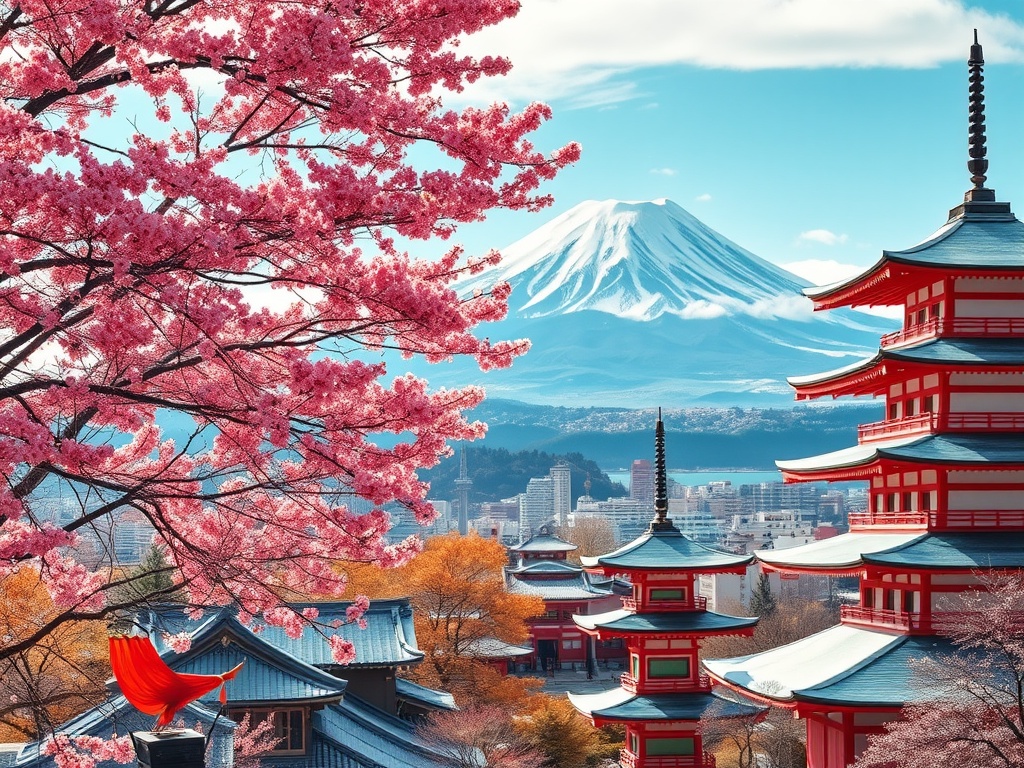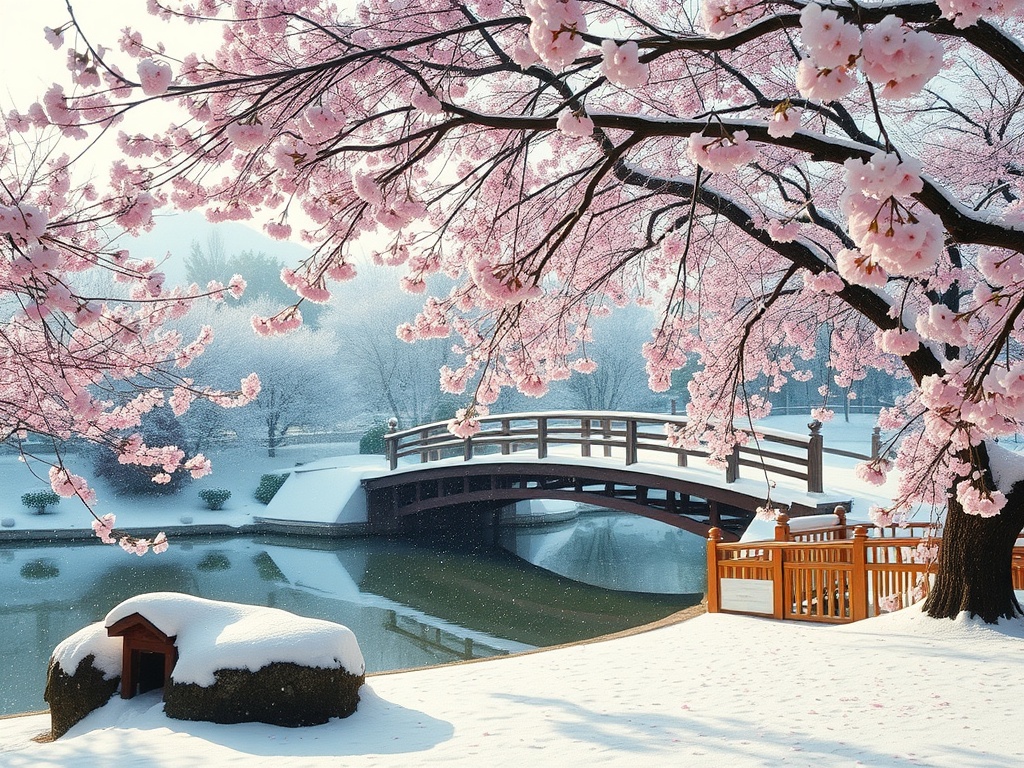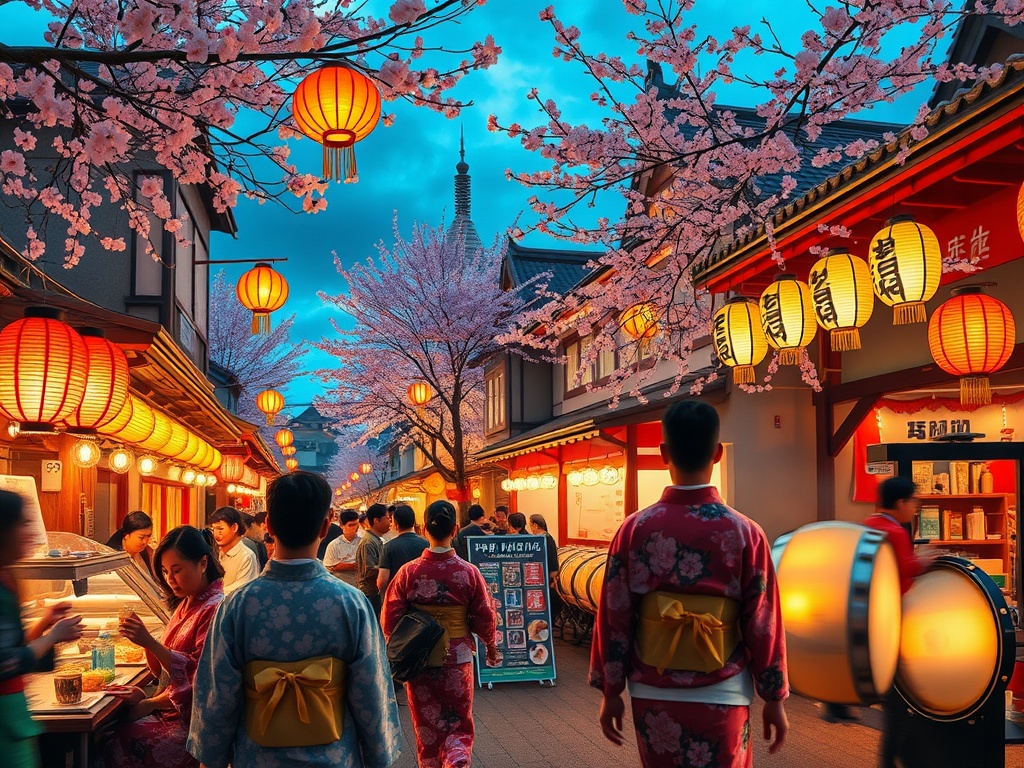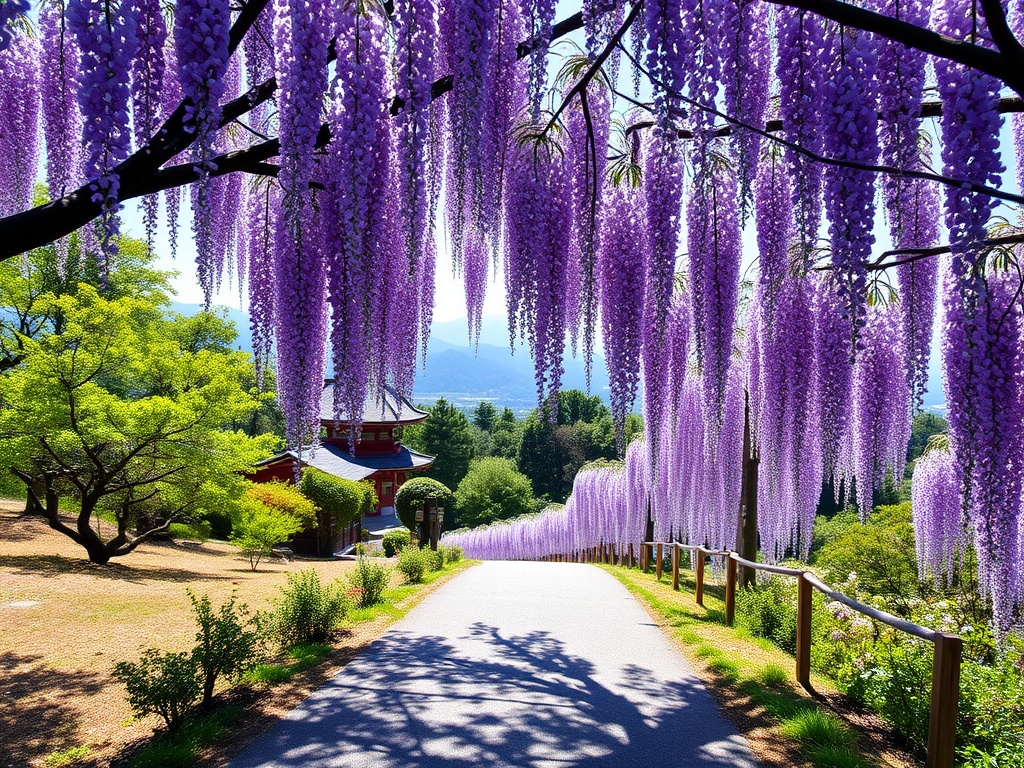Cherry Blossoms & Snow: The Seasonal Dance of Japan
Win a Free Trip to Japan!
Experience cherry blossoms and ancient temples
Japan is a country that dances with the seasons, each one bringing its own unique beauty and charm. From the delicate hues of cherry blossoms that paint the spring skies to the pristine snow that blankets winter landscapes, Japan offers a symphony of sights and experiences throughout the year. For travel enthusiasts, understanding these seasonal rhythms is key to planning the perfect adventure.
Spring in Japan is synonymous with sakura, the cherry blossoms that burst into bloom, turning cities and countrysides into breathtaking canvases of pink and white. This fleeting beauty is celebrated nationwide with hanami or flower-viewing parties, where locals and tourists alike gather under the blooming trees. The best time to catch this floral spectacle varies from late March to mid-April, depending on the region. Popular spots include Tokyo’s Ueno Park and Kyoto’s Philosopher’s Path.
- Ueno Park, Tokyo: One of the most popular spots for hanami, offering over 1,000 cherry trees.
- Philosopher’s Path, Kyoto: A scenic stroll along the water, lined with cherry trees.
As the temperatures drop, Japan transforms into a winter wonderland, offering travel enthusiasts a different kind of magic. From the northern island of Hokkaido, renowned for its world-class ski resorts and the enchanting Sapporo Snow Festival, to the traditional onsen towns like Hakone and Yudanaka, winter in Japan is a time of cozy indulgence and snowy adventures. Don’t miss the chance to witness the adorable snow monkeys of Jigokudani basking in hot springs.
Here’s a quick guide to some must-see winter attractions:
- Sapporo Snow Festival: Experience incredible ice sculptures and snow art.
- Jigokudani Snow Monkey Park: Watch snow monkeys relax in natural hot springs.
- Hakone Onsen: Unwind in thermal waters with views of Mount Fuji.
Festival Fever: Dive into Japan’s Cultural Extravaganza
Japan is not just a land of stunning natural beauty but also a vibrant tapestry of cultural festivities. Timing your visit to coincide with one of Japan’s many festivals can elevate your travel experience to an unforgettable level. These festivals, or matsuri, offer a unique glimpse into the heart of Japanese culture, deeply rooted in tradition, community, and celebration.
Summer in Japan is synonymous with a whirlwind of festivals, each offering its own distinct charm and experience. Imagine the air filled with the rhythmic beats of traditional taiko drums, the night sky illuminated by spectacular fireworks, and the streets bustling with locals adorned in colorful yukata. From the grand Gion Matsuri in Kyoto, where magnificent floats parade through the streets, to the vibrant Nebuta Festival in Aomori, featuring massive illuminated floats, summer is a time when Japan comes alive with a cultural fervor that is simply infectious.
As the intense heat of summer gives way to the crisp air of autumn, Japan continues its festive spirit with events that celebrate the bounty of the harvest. The Takayama Autumn Festival, held in the picturesque town of Takayama, showcases intricately crafted floats adorned with stunning decorations, creating a mesmerizing sight against the backdrop of vibrant autumn foliage. Meanwhile, the Kishiwada Danjiri Festival in Osaka offers a thrilling spectacle as teams race through the streets with ornately decorated wooden floats. Autumn festivals in Japan not only highlight the country’s agricultural heritage but also offer a chance to savor seasonal delicacies and partake in traditional dances and rituals.
Escape the Crowds: Discover Japan’s Hidden Seasons
Japan’s renowned seasonal allure often draws throngs of tourists eager to witness its famous cherry blossoms and vibrant festivals. But for those seeking a more intimate experience, timing your visit during Japan’s lesser-known seasons can reveal a different, equally enchanting side of this island nation. These hidden seasons offer a serene landscape unmarred by crowds, allowing for a deeper connection with Japan’s natural and cultural wonders.
While cherry blossoms take center stage, the early spring months of February to early March offer a tranquil opportunity to witness the awakening of Japan’s landscapes. This period, often overlooked by international travelers, offers a chance to enjoy the plum blossoms that precede the sakura spectacle. Parks and gardens across Japan, such as Kairakuen in Mito, are adorned with these pink and white blooms, creating scenes of exquisite beauty without the bustling crowds. Visiting during this time also means milder weather and the opportunity to partake in local traditions like ume matsuri, or plum festivals, which celebrate this early floral display.
As the vibrant summer festivals draw to a close and the temperatures begin to cool, August transitions into a quieter yet equally captivating time to explore Japan. This post-festival period, often referred to as the late summer lull, is perfect for discovering Japan’s natural beauty. Hokkaido’s flower fields are in full bloom, offering a rainbow of colors without the summer’s usual hustle and bustle. Coastal areas present a tranquil retreat, where warm breezes and the gentle lapping of waves create a peaceful ambience. This is an ideal time to explore Japan’s rural landscapes, engage in leisurely hikes, and relish the seasonal delicacies that mark the end of summer.
Weather Wonders: Navigating Japan’s Climate Like a Local
Embarking on a journey through Japan requires more than just a plane ticket and a camera. To truly experience the essence of this vibrant nation, one must understand its ever-changing climate, which plays a pivotal role in shaping everyday life and travel experiences. Japan’s diverse geography gives rise to a variety of weather patterns, each offering unique opportunities and challenges. By mastering the art of reading Japan’s climate cues, you can align your itinerary with the country’s natural rhythms, much like a local would.
Japan is a land where the four seasons are deeply revered, each offering its own distinct charm and activities. From the lush greenery of summer to the crisp, refreshing air of autumn, understanding these seasonal variations is key to planning your itinerary. The climate changes can be drastic, with northern regions experiencing snow while the southern islands bask in subtropical warmth.
- Spring: Mild temperatures and blooming flowers mark the arrival of spring. It’s a time when Japan shakes off its winter coat, showcasing a vibrant tapestry of new life.
- Summer: Known for its heat and humidity, summer is the season of festivals and fireworks. Coastal escapes and mountain retreats offer respite from the urban heat.
- Autumn: The air turns crisp, and foliage transforms into a fiery palette of reds and golds, perfect for scenic hikes and cultural festivals.
- Winter: Snow blankets the landscapes in the north, creating ideal conditions for skiing and snowboarding, while the south remains pleasantly mild.
Japan’s regional climate variations are significant, necessitating a tailored approach to travel planning. Whether you’re exploring the snowy landscapes of Hokkaido or the tropical beaches of Okinawa, understanding these differences can enhance your experience manifold. Here’s a brief guide to Japan’s regional climates to help you plan accordingly:
| Region | Climate Characteristics |
|---|---|
| Hokkaido | Cold winters with heavy snow, mild summers |
| Tohoku | Cold winters, pleasant spring and autumn |
| Kanto | Hot and humid summers, cool winters |
| Kansai | Hot summers, mild winters |
| Okinawa | Subtropical climate, warm year-round |
By aligning your travel plans with these climate insights, you’ll not only avoid unpleasant weather surprises but also tap into the best that Japan has to offer, just like a seasoned traveler.
Culinary Calendar: Savoring Japan’s Seasonal Delights
In Japan, the changing seasons not only alter the landscapes but also transform the culinary landscape, offering travel enthusiasts a chance to indulge in a festival of flavors. Each season brings with it a unique array of ingredients and dishes, allowing visitors to savor the essence of Japan through its diverse cuisine. Understanding Japan’s culinary calendar can enhance your travel experience, providing a deeper connection to the culture and traditions that define this extraordinary nation.
As the chill of winter gives way to the gentle warmth of spring, Japan’s kitchens come alive with fresh and vibrant ingredients. Spring is the season of renewal, and this is reflected in dishes that feature young bamboo shoots, fresh greens, and sakura-themed delicacies. A highlight of this season is the cherry blossom-inspired treats, such as sakura mochi, a sweet rice cake wrapped in a pickled cherry leaf, and sakura-flavored sweets and drinks. Spring is also the time to savor sansai, or wild mountain vegetables, which are often used in tempura, bringing the taste of nature to your plate.
The heat of summer calls for dishes that are light, cooling, and refreshing. Japan’s summer cuisine is designed to combat the high temperatures, featuring cold noodles like somen and hiyashi chuka, often served with dipping sauces or light broths. Grilled eel, or unagi, is a traditional summer delicacy believed to boost stamina. The vibrant summer festivals also bring an array of street foods, from savory takoyaki to sweet kakigori (shaved ice), offering a taste of Japan’s culinary creativity in every bite.
Budget Bliss: Timing Your Trip for the Best Deals
Japan, a land of timeless allure, offers a journey that can be both enriching and economical if planned with precision. As you weave through the intricate tapestry of cultural festivals and breathtaking landscapes, knowing when to travel can make a substantial difference in your experience and expenses. Whether you’re drawn by the serenity of early spring blossoms or the vibrant hues of autumn, understanding Japan’s seasonal variations can help you unlock a treasure trove of opportunities.
Embrace the charm of Japan’s lesser-known seasons to enjoy a more intimate and budget-friendly adventure. Early spring, just before the cherry blossoms take center stage, and late autumn, as the last leaves fall, offer a tranquil escape from the tourist-heavy periods. During these times, flights and accommodations are often more affordable, allowing you to explore Japan’s hidden gems without breaking the bank. Imagine wandering through serene landscapes and quaint villages, where the absence of crowds allows for deeper connections with local culture and traditions.
Flexibility is your ally when seeking the best deals in Japan. Travel during transitional periods, such as the end of the winter season or the start of summer, when demand is lower and prices drop. This approach not only helps in securing better rates but also provides a unique perspective on Japan’s ever-evolving climate. By adjusting your itinerary to fit these shifts, you can indulge in seasonal delights and experiences that are both authentic and cost-effective. Whether savoring spring’s fresh produce or enjoying the late summer calm, embracing Japan’s cyclical nature can lead to an unforgettable and economical journey.



